1. Introduction
Floods are the natural disasters that cause most damage in Spain. They are unavoidable natural phenomena that are partly beneficial and necessary for proper maintenance of aquatic eco-systems and so a balance has to be struck that makes it possible to minimise the risks, impact and harm generated by floods to human health, the natural and cultural heritage, properties or economic activities while respecting the natural dynamics of river-ways.
This article analyses the line of work being carried out to reduce the negative effects caused by flooding since the coming into effect of the Floods Directive and with a focus on the Coastal Galicia Hydrographical District (DHGC for the Spanish).
The DHGC comprises a group of water basins that flow in their entirety within the territory of the Regional Autonomy of Galicia and include the bodies of both surface and underground water as well as associated stretches on the coast and in a state of transition.
Given that this is a basin within the Regional Autonomy, the management of the hydrological planning and the Public Hydraulic Domain, which covers the handling of extreme events such as flooding and droughts is performed by the Regional Autonomy via Augas de Galicia, which is a body that operates under the Regional Ministry for the Environment and Territory of the Xunta de Galicia (Galicia’s autonomous government).
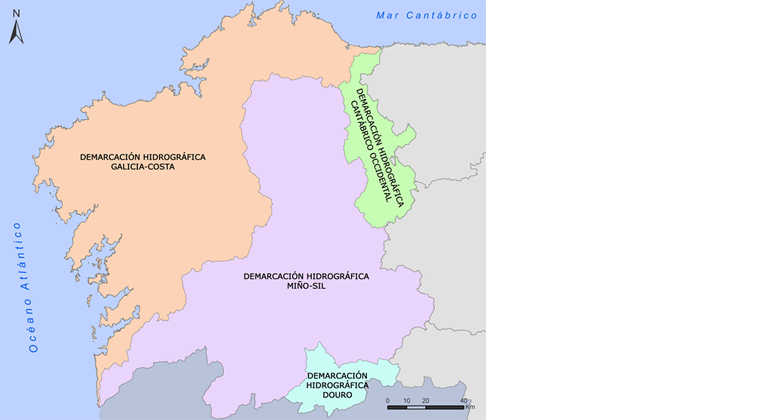
Figure 1. Area covered by the hydrographical districts in Galicia.
As a water basin body in the DHGC, Augas de Galicia assumes the role of coordinator throughout the entire process of implementing the Floods Directive and promotes the conducting of all the necessary studies, though always in coordination with the authorities with jurisdiction in matters concerning the handling of flooding at both state and autonomic or local level: territorial and urban development planning, the rural domain, civil protection…
As we shall see, coordination of this kind is one of the key factors in managing to reduce the adverse effects of flooding since the work has to be carried out by promoting measures that embrace both prevention, preparation and protection and recovering and learning from every event.
2. Characterisation of flooding in Coastal Galicia
We can sort floods into four groups according to their origin:
- River / fluvial floods: Heavy rains that increase river flows.
- Rain-caused / pluvial floods: Heavy downpours that build up surface run-off.
- Coastal: The effect of tides and swells that brings about a rise in the sea level.
- Snow: Prompted by the thawing of snow, although in the case of Coastal Galicia flooding of this kind is not significant.
The most major types in Coastal Galicia are fluvial and coastal floods and locally, sat certain points (normally in urban population centres), pluvial floods.

Figure 2. Fluvial floods (River Eume).
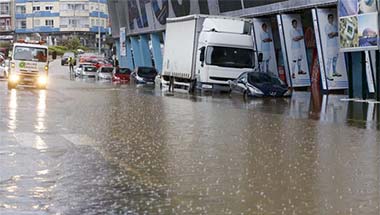
Figure 3. Pluvial floods (Vigo).
The first available historical records of fluvial floods in the Coastal Galicia area are from winter 1584, when the River Mandeo in Betanzos surged, which mainly affected communications. The first marine flood on record was in November 1684, when an unusually high tide partly flooded the city of La Coruña (1).
Floods have thus taken place throughout history and are nothing new. Even so, with the gradual populating of the flood plains their consequences are becoming increasingly serious since the natural dynamics of the basins is changing and it is this, in combination with studies that predict extreme phenomena occurring more often, which means that investigating floods and taking measures have become very important in recent years.
This set of problems obviously does not merely affect the regional autonomy of Galicia but flooding is the main cause of natural disasters in Europe and in Spain, which prompted the drafting of Directive 2007/60/EC on the assessment and management of flood risks with a view to dealing with this problem in the European Union by unifying standards and setting out a clear framework whereby the Commission should act.
The significance of flooding is for example reflected in the figures provided by the Consorcio de Compensación de Seguros (CCS), which sets a value on compensation pay-outs for flooding and waterlogging in the 1987-2016 period at 4.890 billion euros, which represents an annual average of 163 million. Of all the types of claims which the CCS has to handle, flooding accounts for the highest percentage at 68.8% of pay-outs overall in the period alluded to (2).
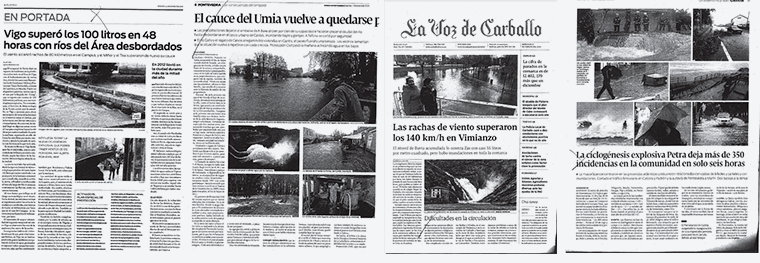
Figure 4. Examples of the coverage of flooding in the media.
In coastal Galicia more than 14,700 km of river and 1,500 km of coastline, together with a highly scattered population, make for a district where fluvial or coastal floods represent the natural phenomenon that is responsible for the greatest amount of damage to both property and persons in Galicia after sea-swells and winds.

Figure 5. Density of the river network for the Coastal Galicia Hydrographic District.

Figure 6. Population dispersion in Coastal Galicia.
If we focus on the river element, it should be noted that the Ulla and Tambre, the basins in the Coastal Galicia, are small and very sloped, meaning that the Times of Concentration (TC) are very short. this implies that from when it rains up until the rivers start to overflow there is very little time so the response time has to be very short. In 71.4 % of the basins, the times of concentration vary between 1 and 12 hours.
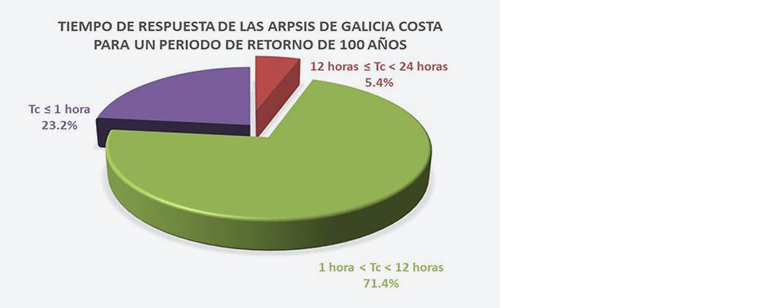
Figure 7.
The pressure to which the basins are subjected given the various activities pursued by man may constitute increased risk and vulnerability:
- Occupation and urban development on flood plains and in coastal areas.
- Narrowing of rivers.
- Effects of drainage works and bridges with little capacity.
- Drainage outlets beneath the tide level.
- Deforestation (fires, changes in use of forests).
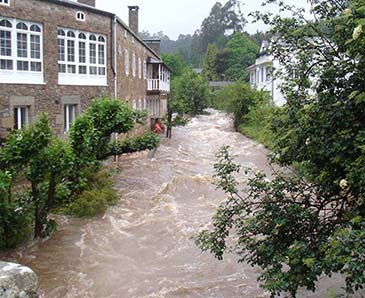
Figure 8. Flooding on the River Xunco (Cervo). June 2010.

Figure 9. View of fires in Galicia. Satellite image.
The fires that tear through Galicia are often followed by bouts of flooding, as the run-off levels increase owing to deforestation and the increasing waterlogging of the ground which reduces seepage into it.
By way of example we can cite those which happened in 2006, when, after a summer of massive fires in many of the basins in the district, the incoming of a chain of highly active fronts in October, November and December led to widespread flooding in the Coastal Galicia Hydrographic District.
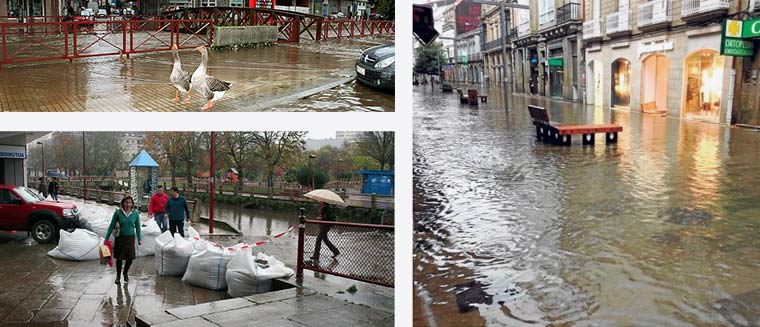
Figure 10. River Con (Vilagarcía de Arousa). 2006 floods.
Source: “El correo gallego” and “El ideal gallego”.
3. New managment focus with the directive 2007/60/EC
Traditional flood management, as with all water management in Spain up to the coming into effect of the Water Framework Directive (WFD), mainly focused on responding to demands and was based, in the case of floods, on taking structural measures: channels for rivers, banking, diversions.... The main aim was to avoid flooding and enable the free occupation of land lying close to rivers in the best possible safety conditions given that they are areas of interest on account of their great abundance of resources and value, being traditionally natural areas where people might settle. This line of traditional work helped flood plains to come to be considered as safe and protected areas and the populace gradually moved into them over time.

Figure 11.
As the floods directive came into force, which was the offshoot of the framework water directive, the focus returned to rivers, where the key objective was to minimise the risk posed by floods to human health, the environment, the cultural heritage and property, as well as economic activities, while conserving the natural dynamics which should take place as regards the river itself.
On the assumption that floods are an inevitable natural phenomenon and a have a side that is beneficial and necessary for properly maintaining ecosystems, we have to learn to live with them and respect the natural space of rivers in such a way as to allow them to expand laterally, thereby minimising the impact and damage generated by flooding and also making the most out of the natural spaces the flood plains represent.
Therefore, in collusion with Framework Water Directive (WFD), the Floods Directive prioritises softer measures (the so-called green infrastructures), which are based on fluvial restoration or bio-engineering techniques relative to those that went before (grey infrastructures) and also enhances management measures. In the case of the WFD it is common to achieve environmental goals (OMAs for the Spanish) with regard to bodies of water so that no anti-flooding measures (except for the most justified of cases) can jeopardise meeting the environmental goals set out under hydrological river basin plans with respect to bodies of water.
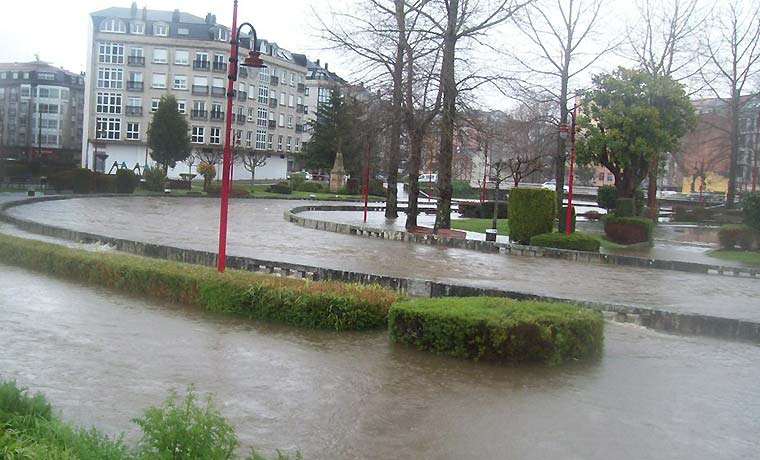
Figure 12. Flooding on the River Anllóns, March 2016 (Carballo).
Besides involving a different concept, its sphere of application also differs, extending to the entire hydrographical district and including the studying of floods that are not only pluvial in origin but also coastal, although on several occasions both phenomena are intertwined, with consideration also being given to floods arising from snow in those areas that are of some consequence.
The new water management policy has been conceived to run for cycles of six years for the purposes of new and ongoing review and updating given the variability of the phenomena, the improvement in available techniques, in both cartography and hydrology and hydraulics or the alteration and modification of uses of the land or characteristics of the terrain.
This whole change of philosophy means greater knowledge and characterisation of the risk zones so as to be in a position to define appropriate measures.
4. Studies
Based on what is established in Directive 2007/60/EC on the assessment and management of flood risks transposed into the Spanish legal system by Royal Decree 903/2010 of 9 July, a set of studies are being set in train at hydrographic district level that are grouped into three phases which bring to a close the planning cycle that will be repeated every six years.

Figure 13.
To begin with identification must be made of the district zones that represent the greatest risk of suffering from flooding bearing in mind several factors. Thus the Areas with Significant Potential Risk of Flooding were identified (APSFR), as regards both the fluvial and coastal varieties. All of these studies are summed up in the study known as the “PFRA”, or Preliminary Assessment of Flood Risk.
In a second phase, for each of the APSFRs detailed studies are made of floodability and flood plains delimited with depths and speeds achieved by sheets of water (hazardousness maps) for different return periods from 2.33 to 500 years. Likewise, all major elements located on the flood plain were identified, from the population living in the zones, the economic activities that they engage in, existing protected areas and other elements of particular importance that are situated in these exact zones (sewage treatment plants, heritage-related features, educational centres, hospitals and health centres, transport points...) and the relevant risk maps are drawn up. The result of such studies is what is known by the name of Flood Risk and Hazardousness Maps.
Then in the third phase of each cycle, by analysing the information gathered a Flood Risk Management Plan is developed, which includes a set of measures to minimise the risk based on the findings from the previous phases and also clearly marking out guidelines or a philosophical approach to follow in handling flooding in the district.
So as to ensure a maximum of participation and involvement by all the parties concerned, both government bodies and the population at large, all of these phases have information and querying facilities available for the public and efforts are made to boost their active involvement with workshops and conferences etc.
From the point of view of the Coastal Galicia Hydrographical District (DHGC) it is very important to define a strategy that brings together all the stakeholders with significant roles as regards this matter in a coordinated manner, since synergies are sought among the various different actions or measures that can be used to obtain an optimal result.
All this work bore fruit in the form of Royal Decree 19/2016 of 15 January whereby endorsement was given for the 2015-2021 Flood Risk Management Plan for the Coastal Galicia Hydrographical District (DHGC).
We are currently in the period to which this plan applies and getting the various different measures in it underway, while at the same time starting to develop the tasks for the second cycle, which will culminate in the review and update of the Plan in December 2021.
To illustrate all of this process which has been carried out and familiarise ourselves with the available information it is a good idea to examine not just the results obtained, but also the set of problems which we have come up against along the way.
4.1. Where does flooding take place?: Preliminary assessment for flood risk
In Coastal Galicia 168 fluvial APSFRs were defined by Augas de Galicia and 39 coastal APSFRs by the Directorate General for Sustainability of the Coast and the Sea (Ministry of Agriculture, Fisheries, Food and the Environment).
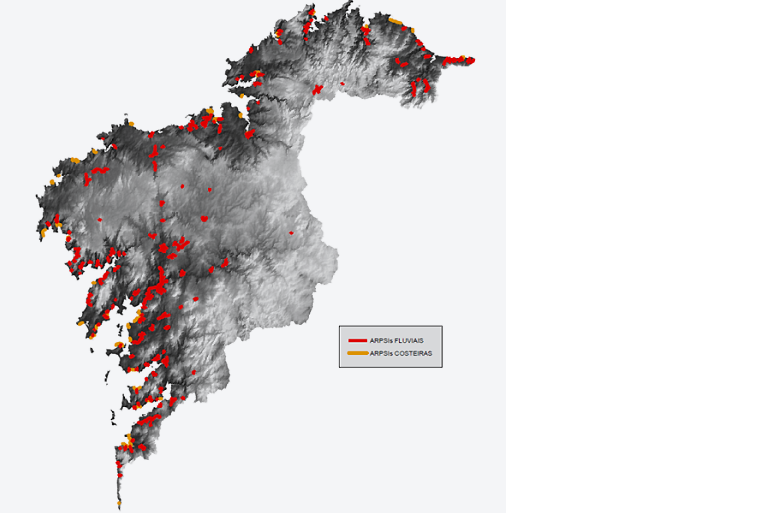
Figure 14. APSFRs marked out in Coastal Galicia. Fluvial and Coastal.
To determine and select these zones several different sources were used and zones identified both which have historically experienced flooding problems and others that are potentially floodable due to their characteristics, for example those of a geomorphological type. The work was done using all of the information available on how the land was used (SIOSE or Corine Land Cover), geological and geomorphological information (MAGNA, GEODE plan), as well as cartographic information from the National Air Ortho-photography Plan (PNOA), existing floodability studies, dam emergency plans or event information from Civil Protection and the Consorcio de Compensación de Seguros.
They thus managed to identify as many as 5,893 km of rivers having a certain risk of flooding. It should be pointed out that it is self-evident that wherever there is a river it can overflow but the aim is to ascertain what the areas are where this risk is significant.
For these purposes risk was assessed for the 5,893 km of rivers and a buffer was established or controlled flooding zone depending on the area of the river basin providing these points on the river, where the uses of the land in this pocket of bits of land was identified and they were assigned a risk value on a scale of 0-1 according to the uses of each river basin.
It was thus possible to establish a certain threshold above which the risk increased exponentially with the trend in the risk versus km of river curve changing, past which point it was considered that the risk in the zone is significant.

Figure 15.
Past this threshold the 168 APSFRs were demarcated that were characterised in the DHGC, which represent a total of 543 km of river with significant potential risk of flooding.
4.2. How much flooding is there and what is affected?: Flood risk and Hazardousness Maps
After the APSFRs have been pinpointed the next task consists of demarcating the extent of the flooding, how far it goes and at what speeds and depths the water arrives at when there is an overflow. This allows us to characterise the hazardousness of each zone.
Such analysis will be strongly influenced by the flow that will pass at any time, for which reason three scenarios with different probabilities of occurring are studied:
- Scenario with a high probability of occurrence (return period T of 10 years): one assumes flows might pass along the river on exceptional occasions but they have a high probability (1/10) of taking place.
- Medium probability scenario (return period T of 100 years): these are greater flows than those above but with a probability of occurring of 1/100.
- Low probability scenario (return period T of 500 years): - rare situations with very high flow rates that have a very low likelihood of occurring (1/500).
For studying floods, it is important to grasp the concept of the
return period (T), which is very usual in engineering for design and represents the likelihood of an event occurring. The highest return periods thus relate to events or phenomena with a lower probability:
Return period T=500 => Probability of appearing P=1/500
Even so, the fact that the probability of appearance may be very low does not imply that events might not occur today or tomorrow, and, for example, a return period of 500 years is a very common standard for scaling in civil engineering infrastructure such as bridges or other drainage construction work.
Bearing in mind these three scenarios hazardousness maps are made for each section, which are the fruit of studies that are diverse in nature, including those that are cartographic, hydrological, hydraulic, historical or geomorphological.
Besides these three scenarios using an approach that relates to managing hydraulics in the public domain, what is known as a Cartographic Public Domain (DPH for the Spanish) was determined by performing detailed studies that enable mapped demarcation of the DPH pursuant to the definition described in the Augas norms and the preferential flow zone.
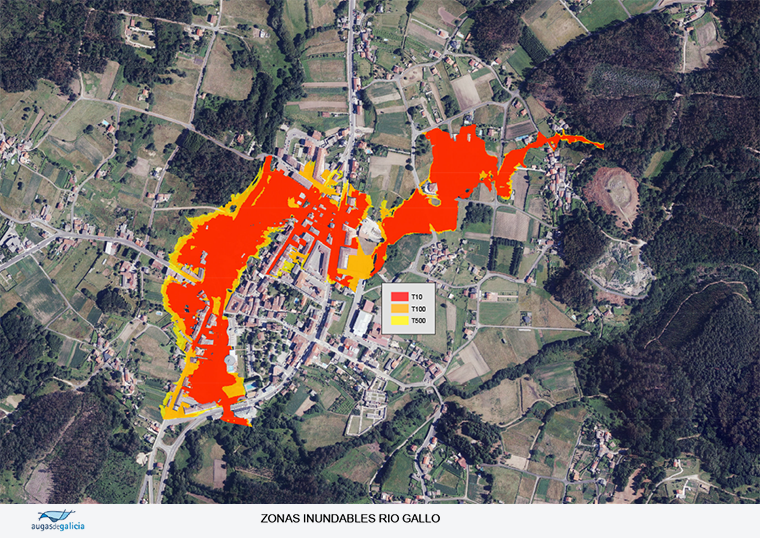
|
Figure 16. Hazardousness maps. T 10, 100, 500 years.
|
Determining this preferential flow zone could be considered a measure in its own right to decrease flood risk, since what it seeks to identify is the zone where, if a flood happened, serious loss or damage might arise to people and property and where, once it has been demarcated, it could be possible to set legislative restrictions on uses. These are zones located next to the channel, where the depths and speeds which the water might develop are such that serious damage or loss can occur, for which reason any use to which such zones are put is very limited.
After the characteristics of the flooding itself have been specified it is important to know what might be affected if the river overflows.
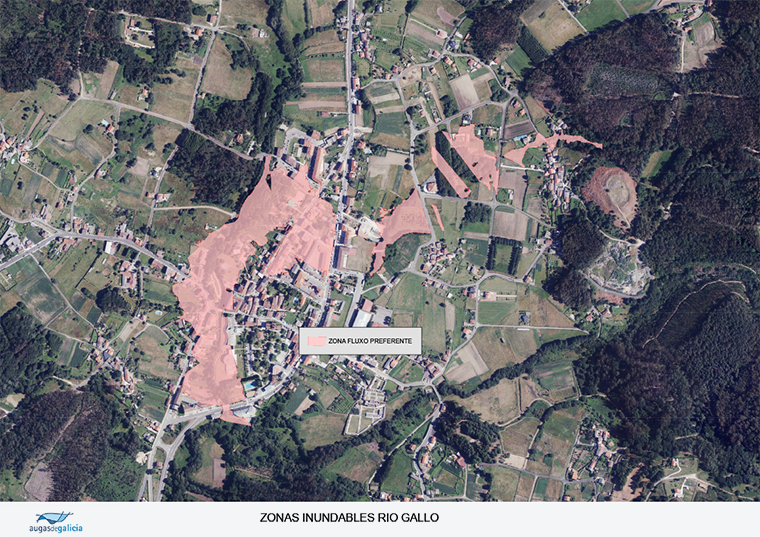
Figure 17. Hazardousness maps. Preferential flow zone.
The population who lives in the zones that are flooded under the three scenarios is studied (T=10, 100 and 500 years), as are the economic activities that could be affected, as well as exposures of particular significance in the floodable zone: industrial facilities, sewage treatment plants, cultural heritage sites, points of special interest for civil protection work and environmentally protected areas (collection systems for water intended for human consumption, bodies of water used for recreational purposes, zones for protecting habitats or species and bodies of water subject to the Framework Water Directive). With all this information a decision is made on the exposure and vulnerability of each use the risk maps are made for each APSFR (Areas with Significant Potential Risk of Flooding).
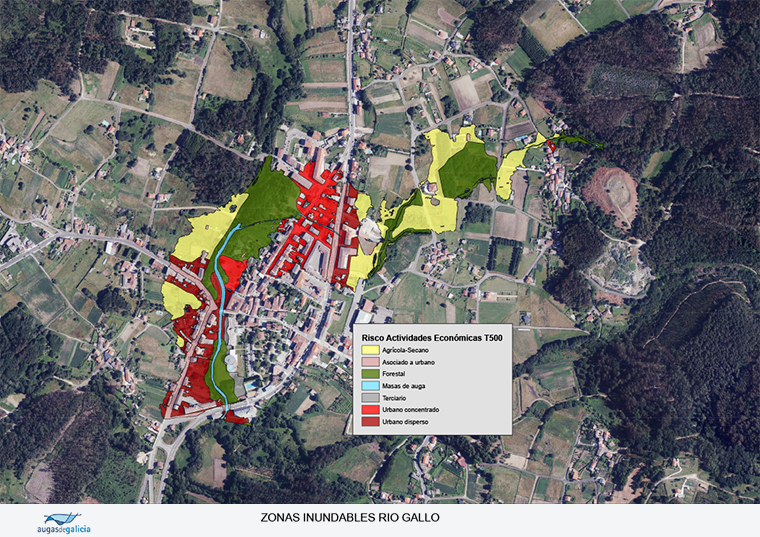
Figure 18. Risk maps.
Thus, as a result of the second phase studies and for each of the APSFRs you can consult the extent, speed and depth of floods (hazardousness maps) and what elements, property or people might be affected (risk maps). All this information is available via the cartographic viewer that belongs to the National Cartography System for Floodable Zones (SNCZI for the Spanish) and, in the case of Coastal Galicia, the viewer of Augas de Galicia: Spatial Data Infrastructure of the Coastal Galicia Hydrographic District (IDE-DHGC).
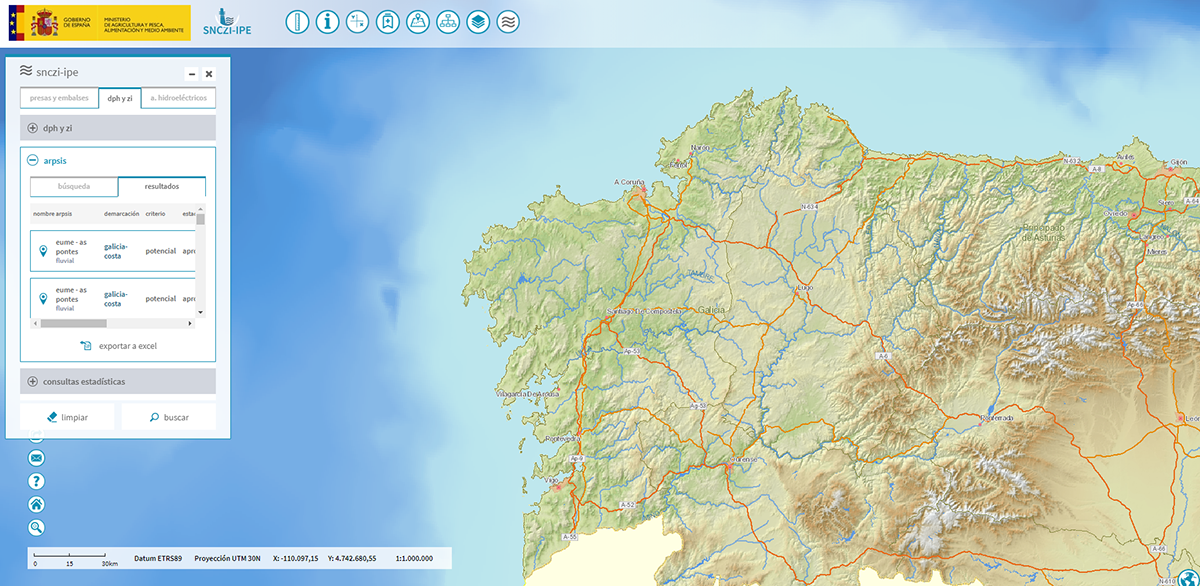

5. Flood risk managment plan
5.1. What do we do?
By way of culmination of the process, after it has been discovered which zones have the most risk and any floods that might occur have been characterised, the steps have to be taken that allow us to reduce / eliminate the risk for each zone.
Key points to note here:
- What is sought is to minimise the effects of flooding rather than to avoid them completely, which would be an impossible task as they are natural phenomena and in many cases, they are necessary.
- Priority is given to prevention and preparation measures more than to protection measures, which imply very high investment costs and, in several cases, give rise to a false sense of security which encourages people to move into flood plains.
- All government bodies with competency as regards the matter are involved and a coordinated programme of measures is established to make the most of any synergies from the various different lines of action. Coordination of this kind is spearheaded by river basin organisations who are in charge of drawing up the Flood Risk Management Plan, although clear involvement by all the stakeholders concerned is required: Civil Protection, Coastlines, the State Meteorological Agency (AEMET), arms of government with jurisdiction with respect to Territorial Planning and Urban Development, those with competency as regards the rural environment, town and city councils, dam owners, the Consorcio de Compensación de Seguros, the State Company for Agricultural Insurance and even private individuals.
As we have already stated, this phase represents a very substantial change, given that it is not exclusively focused on protective action which was what was traditionally done, but instead the intention is to take all the necessary steps to avoid risk and get one step ahead of flooding via preventive and preparatory measures, other action that has to kick in during the flooding (protective measures), and any action needed to bring everything back to normal in the affected areas (repair and review measures).
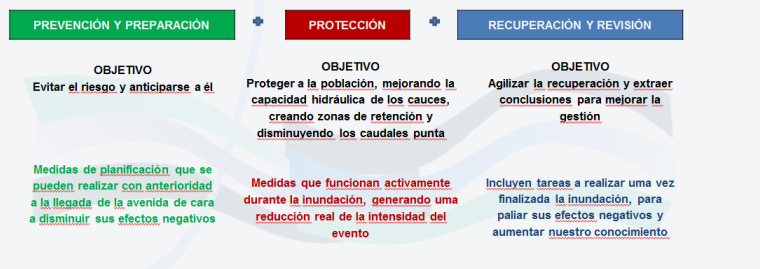
Figure 21.
With regard to these three lines of work the most notable measures are:
- The fundamental basis for avoiding risk involving adequate territorial planning and urban development zoning. Work has been conducted along with the bodies in charge of these matters to make them increasingly aware of this issue. The intention is not only to avoid urban developments and pressure on the actual flood plain itself, but also to make development orderly at basin level, since the changes in the way the land is used can give rise to major alterations to the run-off for a zone, which aggravates flooding problems or shifts them elsewhere.
Among the measures already being implemented over the course of this cycle are the legislative amendments to Galicia’s Land Act, which this line of work already incorporates, or the change brought in by Royal Decree 638/2016 of 9 December amending the DPH (Hydraulics in the Public Domain) Regulations, the Hydrological Planning Regulations and other regulations concerning flood risk management and which have been another major lanWFDrk in handling flood risks.
By laying down restrictions on land uses the idea is for authorisation only to be given to activities compatible with flooding (to the extent that this is possible) in areas prone to floods.
Such limitations on uses, which are already sparking considerable controversy as they could act as a brake on development expectations in certain zones, are above all intended to keep people, economic activities and the natural and cultural heritage safe. It is thus important to make efforts to inform, raise awareness and educate the entire population so that all of these restrictions are understood to be for the sake of safeguarding people and property and based on technical studies using the best available techniques and resources.

Figure 22. Informative leaflet on Royal Decree 638/2016.
- In the case of basins such as Coastal Galicia being one step ahead of the phenomenon is very important because once overflowing starts to take place there is very little response time given that the times of concentration very low.
This is why work is being done on boosting the development of systems of prediction in real time, where, by using weather forecasts provided by Meteogalicia, flow predictions are made at various points in the district over a 72h horizon. This means that if flows are anticipated that are too great for the watercourse to manage, coordination can be set up with Civil Protection and resources can be readied for the purposes of monitoring and potential prevention.
Likewise using the data received every 10 minutes from the network on river capacities information can be found out in real time on how flows are progressing, which helps in decision-making.
It is therefore very important for there to be coordination among the government bodies in charge of weather forecasting, the basin organisations and Civil Protection both before and during flooding so as to step in ahead and take the necessary measures to allow damage and loss to be minimised.
- Any actions that imply improved hydraulic function, as well as avoiding basins becoming watertight, will minimise the adverse effects of a flood. Suggested measures to take include river restoration and the conservation and maintenance of water-courses, using drainage surfacing or appropriate agro-forestry planning to be developed by the various government bodies.
- In keeping with protection measures, even if nowadays structural activities can be avoided, such as canalisation, in certain zones where there is a settled population measures should be taken that swing into action whenever a river rise occurs, thereby restricting any overflowing and protecting the population. These days measures of this kind focus on protecting whatever is already there, but they should not be given consideration as a way to increase flood plain occupation.
- During the flood the key actor is Civil Protection.
Here it is worth noting the involvement of the Xunta de Galicia’s Civil Protection force throughout the entire process being carried out in the DHGC (Coastal Galicia Hydrographical District). Such engagement is exemplified in the reviewing and updating of the INUNGAL (Civil Protection Flooding Plan for Galicia) which has incorporated the guidelines from the Floods Directive and findings from the studies conducted in recent years. By the same token the development of Municipal Action Plans is being promoted to counter the risk of flooding, in which more precise definition is given to the strategy for intervening and taking action before, during and after a flood.
- Civil Protection and the Consorcio de Compensación de Seguros are the major players when it comes to the recovery process. Over the years it has been noted that encouraging property insurance is important in areas such as Galicia, which has a sizeable rural population, so that if an extraordinary event such as a flood occurs, the effects of losses can be kept to a minimum and both recovery and a return to normality can be achieved as speedily as possible.
The diagram below offers a summary of the kinds of measures considered in the DHGC’s flood risk management plan.
| TYPES OF MEASURES |
| Territorial Planning and Urban Development measures |
Encouraging territorial and urban development to respect the river's natural extent so as to avoid exacerbating risk and vulnerability |
 |
| River restoration measures as well as others targeting hydrological/agro-forestry restoration |
Coordination with forestry plans |
 |
| Programmes to maintain and conserve water-courses and channels |
| Removing obstacles to maintain transport capacity |
| Recovering river space and increasing the capacity of sheets of water |
| Implementing Urban Drainage Systems to reduce the water-flows that reach water channels |
|
| River surge prediction measures |
Official Capacity Network (ROA for the Spanish) for the Coastal Galicia Hydrographic District |
 |
| Weather Alert Systems: AEMET/MeteoGalicia (weather forecasting) |
| Early warning systems: Artemis (hydrological prediction) |
| River Umia's SAIH (automatic hydrological information system) |
|
| Civil Protection Measures: Emergency protocols and plans |
Protocol for action with Civil Protection and dam owners |
 |
| Updating of the autonomic Civil Protection Plan and promoting of municipal plans of action |
| Updating and approving of dam operation rules |
|
| Promoting insurance: CCS and ENESA |
| Measures to improve drainage for linear infrastructure |
 |
| Structural measures and cost/benefit studies of these |
 |
| Raising awareness |
Improving awareness with respect to flood risk management (for example, the effect of climate change) |
| Specific plans to look into and find solutions for the most complex APSFRs (Areas with Significant Potential Risk of Flooding) |
The Programme of Measures in the Flood Risk Management Plan for the Coastal Galicia Hydrographic District for the 2015-2021 period, which was endorsed by Royal Decree 19/2016 of 15 January has a budget of €68M. and includes measures by a considerable raft of government bodies that can be applied to just the APSFRs or across the entire district.
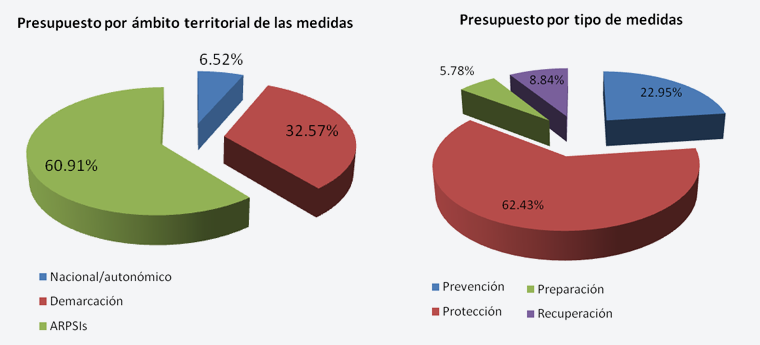
Figure 23.
As can be seen, there are numerous stakeholders and government bodies involved in the process. Thus coordination of all of the actions to be carried out is of vital importance when it comes to achieving the goal set in an optimal manner. Augas de Galicia is drawing up the specific plans for flood risk management for the APSFRs (Areas with Significant Potential Risk of Flooding) that are at greatest risk and which are the most complex in nature to ensure adequate coordination in defining the most appropriate specific plans.
These specific plans are conceived as studies that focus on the APSFR level in territorial terms and in drafting them all of the interested actors are involved, not merely the government bodies but also the population in the zone. For these purposes open days of meetings are set up in the study zones where not only is all the available information provided and the results of the studies made passed on, but also direct communication is set up with the inhabitants of the zone so that the measures taken can be the most optimal for everyone concerned.
In these zones, Augas de Galicia seeks to delve deeper into how the APSFRs function in a hydraulic sense so as to gain a better understanding of the various different cases and frame a set of measures that can successfully integrate the different competent authorities involved. Selecting these measures will be done via cost/benefit analyses, multi-criteria studies and taking into account achievement of the environmental objectives in the Hydrological Plan for the zones, ultimately incorporating the measures chosen along with their associated cost and competent authority for them to be implemented, as well as time scheduling for this.
Organisations such as the Consorcio de Compensación de Seguros, Civil Protection, the Directorate General for Water from the Ministry for Agriculture, Fisheries, Foods and the Environment (MAPAMA) or the Directorate General for Territorial Planning and Urban Development of the Xunta de Galicia, as well as the respective councils are actively involved in this process, which is currently underway in Caldas de Reis, Padrón, Carballo and Vigo.
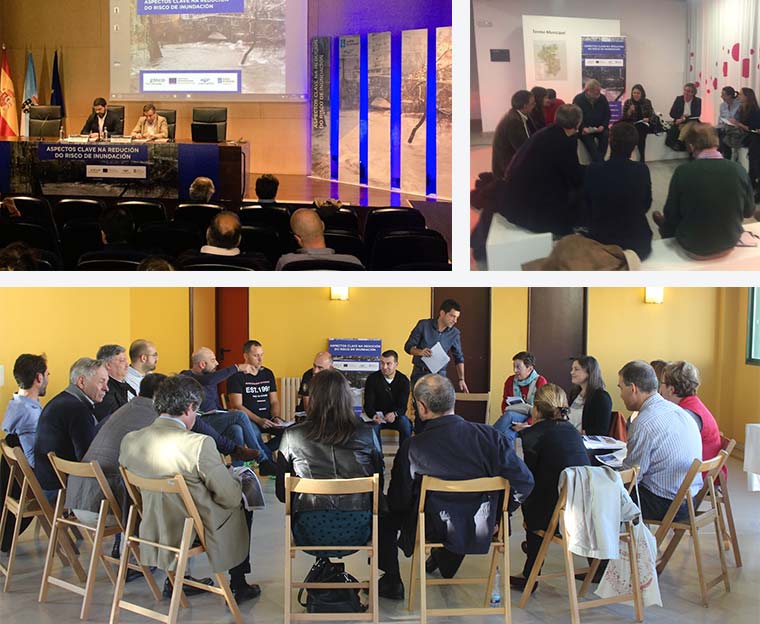
Figure 24. Active participation.
We hope that this article will provide the reader with a fuller picture of the work that has been undertaken in recent years to enhance flood management and help to raise everybody’s awareness of the importance of boosting growth in a way that respects the natural dynamics of rivers.


























